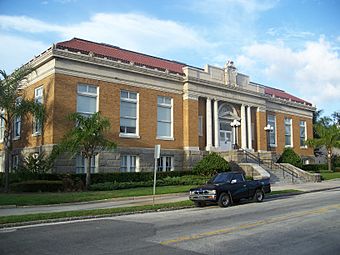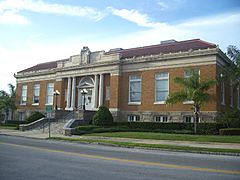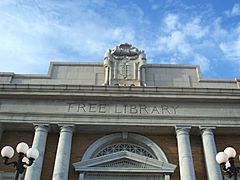Tampa Free Library facts for kids
For other Carnegie Libraries, see Carnegie library (disambiguation)
Quick facts for kids |
|
|
Old Tampa Free Public Library
|
|
 |
|
| Location | 102 E. Seventh Ave., Tampa, Florida |
|---|---|
| Area | less than one acre |
| Architect | Fred J. James; Aulick, Bates & Hundall |
| Architectural style | Classical Revival |
| NRHP reference No. | 91000618 |
| Added to NRHP | May 16, 1991 |
The Old Tampa Free Public Library (also known as the Exceptional Children Education Center) is a historic library in the Tampa Heights neighborhood of Tampa, Florida. Located at 102 E. 7th Avenue, it was one of 10 Florida Carnegie libraries to receive grants awarded by the Carnegie Corporation of New York from 1901 to 1917. It was designed by Tampa architect Fred J. James and constructed from 1915-1917. It was added to the U.S. National Register of Historic Places on May 16, 1991.
Steel magnate and philanthropist Andrew Carnegie provided funding for more than 3,000 Carnegie libraries in the United States, Canada, and Europe. The library was built using a $50,000 grant from Carnegie. The library's first director was Helen V. Stelle.
It was Tampa's main library until 1968. It includes a T-plan, masonry, brown and yellow brick atop a rusticated granite basement, and is topped by a barrel tile roof. The building was rehabilitated in 1999 by the City of Tampa for public offices. It has been occupied by the administrative staff of the Tampa-Hillsborough County Public Library System since November 2016 and also houses the Hillsborough Literacy Council, which is affiliated with the Tampa-Hillsborough County Public Library system.
Library Usage and Floorplan
The library was widely used by patrons across Tampa who had fewer branches to choose from at the time of its use as an active branch; university students would enjoy the ample collection in order to do the research and study required of them. High school students,too, would come to do research at the branch, and some would enjoy going to the pool hall across the street from the library, which was notorious among patrons as well as librarians for having a diverse and interesting clientele that was not always a welcome presence at the library and would sometimes be a source of mischief. At the "7th Avenue Library," as it was called by some patrons, children would enjoy storytelling, which would happen once or twice in the afternoon according to patron memories, and book selection in the children's library on west side of the basement level.
Bernadette Storck, a worker of the library with the cataloging and processing department, details her memories of the library's floorplan and details of processes: The library had a circulation desk on the first floor, with reference on one side and popular materials on the other side. In the downstairs area, the west side housed the children's department, where storytime took place and children's material was kept. On the east side of that floor, cataloging and processing—involving, for example, hand lettering along spines in order to determine branches and subjects took place. The bookmobile collection was also kept there, as Tampa's first bookmobile was also kept in the Tampa Free Library. Upon patron request, backfiles of newspapers and magazines, kept behind smoked glass, would be sent upstairs. A dumbwaiter was used to put materials in and take them upstairs, as the building's current elevator had not been added at the time.
Reasons for Closure
Built in 1915, the Tampa Free Library originally stood as Tampa's main public library. However, over the decades, the library was no longer able to adequately meet the needs of the growing population. Concerns over the small size of the library, lack of expansion, and inability to assist the growing population eventually led to a new building being constructed in downtown Tampa. The original building was constructed and designed to serve 50,000 people which was adequate at the time of its construction. However, by the early 1960s, Tampa maintained a population of 274,407 people. In addition, other old, historical libraries in Tampa were also unable to meet the needs of the public due to poor parking, small size, and cramped collections. This led to questions of whether newer, larger libraries should begin replacing the older, historical models. The Tampa Free library endeavored to cater to the population by expanding hours. In April 1960 the Tampa Public Library's expanded its hours, from 9 a.m. to 9 p.m. Monday through Saturday, increasing the library's open hours from 66 to 72 hours per week. This was done with the hope that it would be more convenient for people working downtown to visit the library.
In 1961, the library was no longer seen as an adequate facility for the growing city of Tampa. As evidenced in an article by the Tampa Tribune in 1961, the library was discussed as being inadequate in space—designated to serve a community of 52,000 people, 274,407 people, with no additions to the building after its construction in 1915. A former worker of the library who'd been involved in cataloging and processing also recalled insufficient shelving space, stating that the huge collection with books, newspapers, and magazines were "falling off the shelves.". In fact, patrons had to travel quite far to the library; the library was used by patrons who lived in Hyde Park and Palma Ceia when it was an active branch, which made for a far distance to travel according to recollections. Therefore, eventually the need for space and change led to the creation of a new main library, currently titled the John F Germany Public Library on 900 N Ashley Drive. Opening on April 21, 1968, the John F. Germany Public Library still acts as the main library in the Tampa-Hillsborough County Library system.
- ==Gallery==







